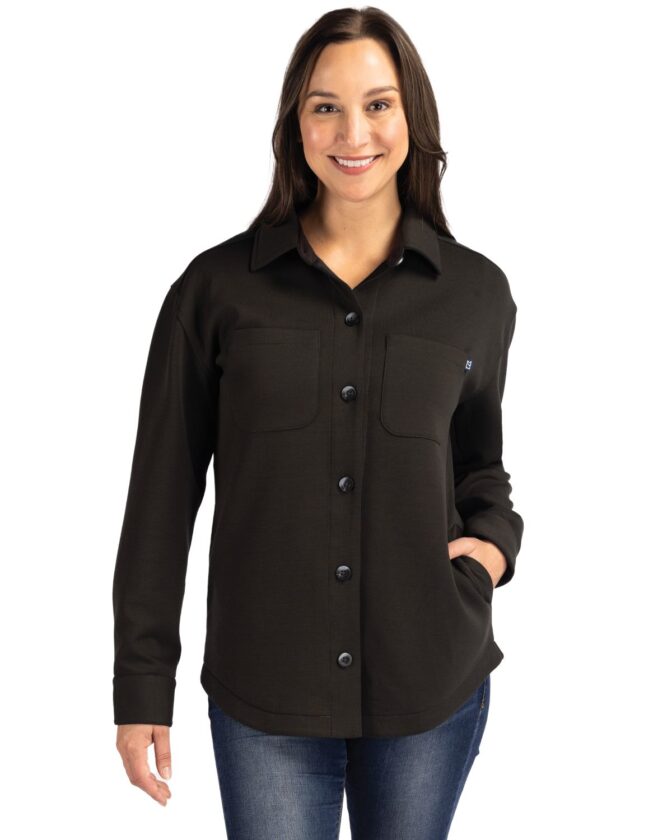Promotional outerwear trends meet several needs for end-users, from functional performance and heritage-inspired style to the ongoing demand for sustainable materials. Distributors note that recipients want pieces that can transition from work to weekend and leisure activities, deliver comfort and durability, and align with shifting environmental priorities.
“At the end of the day for the end-user, functionality is key,” says Shel Renning, vice president of merchandising at Counselor Top 40 supplier SanMar (asi/84863). “We want longevity and wearability – the want-to-wear versus the have-to-wear.”
Renning points to the rising popularity of Americana and American West influences – an aesthetic she says is fueled by TV shows and movies – that ties naturally into workwear. Pieces in durable, natural-feeling fabrics like duck cloth exemplify this; she cites Carhartt’s Montana series of insulated duck garments, including a women’s version with fur around the hood, as an example of fashion meeting practicality.

Jacket quilting continues to hold strong in outerwear, but suppliers are moving beyond standard patterns, Renning says. Larger diamond quilting reminiscent of English riding jackets and heritage looks from brands like Brooks Brothers are highly sought, while “brick,” a quilting style using square panels, and “blue onion quilting,” which uses swirled quilting patterns, are also gaining traction. Outerwear pieces are evolving into true three-season garments, she says, extending their selling cycle well beyond the traditional Q4 winter push.
SanMar has also added Cotopaxi apparel, known for its horizontal quilting in bold, bright colors, to its lineup for the first time.
Using these emerging style trends and popular brands, distributors can build on what is already popular in the promo outerwear space both in terms of silhouettes, designs and proven bestselling brands.
Building on What Works
For Counselor Top 40 supplier Cutter & Buck (asi/47965), the expansion of proven bestsellers has been a winning strategy.
“The Rainier has been our top-selling Q4 gifting piece,” says Mike Rubin, regional sales director, referring to the company’s lightweight, packable puffer jacket. The company has built out its Rainier line to include hybrids, hooded styles, shackets (shirt jackets) and a women’s long jacket – all made with PrimaLoft insulation and sustainable materials. Puffers remain the hot category overall, Rubin adds, including vests that feature soft-shell side panels, and an insulated front and back. These are also a recyclable, sustainable product, Rubin says.
“Cutter & Buck jackets are made from recycled plastic bottles,” he says. “We use post-consumer recycled polyester certified by Global Recycled Standard to decrease waste and our product’s impact on the environment.”
Other Cutter & Buck jackets take their cues from popular retail items. The supplier’s Roam line, Rubin says, nods to Lululemon’s Scuba jacket. (The Roam line also includes a women’s shacket that’s water-repellent.) To name another, the Main Sail outerwear piece – comparable to Patagonia’s Better Sweater, Rubin says – is another corporate favorite.
“It’s nice, lightweight, warm and casual – great for corporate outerwear,” he says.
Sustainability as a Standard Nearly all of Cutter & Buck’s offerings (about 95%) are sustain[1]able. New additions like the Camano rain jacket, made from recycled materials and rated to the Global Recycle Standard, reflect this commitment, Rubin says. For many clients, especially Fortune 500 companies, sustainability is now a baseline expectation for corporate gifting. “They’ll pay,” he says. “They want brand names – and they look for sustainable first.”
John Heinz, a distributor with Spark Branded Solutions, sees the same momentum. “Everything is eco-conscious now,” Heinz says. “That is so big and has always been big.” Products made from recycled materials are perpetually sought-after, he says, especially when combined with performance features like moisture-wicking.
SanMar’s Renning also emphasizes the role of tactile appeal. High-pile and double-sided classic fleeces continue to resonate with consumers who want a soft and cozy hand to what they’re wearing. “There’s a shift from more sweater fleece to a softer, tactile pile fleece,” she says.
Decoration Stays Subtle
Across the board, outerwear decoration trends are leaning toward more subtle and integrated into the garment. Renning says outerwear branding is still very much tonal, with techniques like laser etching on fleece embedding the design into the garment for longevity and wearability. Alex Bowen, director of sales development and strategic partnerships at Barker Specialty (asi/132690), notes a shift toward smaller logos, often 2 to 2.5 inches wide on the left chest rather than the traditional 3.5 inches. “Customers lean toward more subtle, retail-inspired branding,” Bowen says. When larger logos are used, they’re often elevated with appliqué, distressed prints for a vintage look or debossing for a dimensional effect, he says.
Bowen also points out that decoration placement is evolving. “We’re seeing more requests for placements on the side, yoke and even tonal sleeve hits – details that feel like they came straight off a retail rack,” he says. He adds that the shift toward subtle branding is especially strong with younger buyers.
“Millennials and Gen Z are pushing back against being walking billboards,” he says, “so we’re advising clients on how to keep their brand visible but understated.”
Rubin sees a similar pattern. “Tone-on-tone is a subtle look a lot of companies are going with,” he says, though some still opt for high-contrast logos to stand out. Matching a zipper placket to the company logo color is another way brands are making a statement without overwhelming the garment.
Heinz points to patches as a retail-inspired trend making its way into promo, even for outerwear. “When it’s a premium piece, you want people to wear it for years – not shove it in the closet because the logo is overpowering,” Heinz says, reinforcing the move toward understated branding on what are clearly retail-quality pieces.

Retail Sets the Pace
Those same retail cues don’t just influence decoration: They shape the very fabrics, fits and features suppliers bring to the promo market. As retail continues to set the pace for outerwear design, suppliers are working to align their release timing with consumer trends rather than just following the crowd a few seasons later. Renning stresses that if the industry simply follows retail, “we’ll be two years behind.”
Vintage-inspired remakes are a major retail influence, says Bowen, while Rubin sees more hoods – some without drawstrings now – a softer hand, and quarter-zips and layering pieces crossing over from retail lines into promo. Echoing Renning’s comments about Western media influence, Bowen says heritage brands are reworking archival styles.
“There’s a real appetite for ‘new classics’ – styles that nod to the past but are updated for today’s fabrics and fits,” he says. Cutter & Buck’s presence online with retailers like Nordstrom, Target and Kohl’s – and in golf pro shops – keeps the brand in touch with mainstream style preferences. Heinz adds that retail names like Brooks Brothers and Carhartt are leaning further into the promotional space, with some offering full-line releases.
Carhartt outerwear, he notes, is now worn far beyond the job site, broadening its appeal. Silhouettes & Standouts The oversize trend still has legs (or maybe arms), especially in outerwear that’s designed to accommodate layers. Cropped cuts, however, may have reached their limit, with suppliers and distributors saying they’re seeing movement back toward longer lengths. Heinz observes that outerwear is “going a little bit longer again and oversized to allow you to wear something else under it.”
Heinz also points to the ongoing appeal of fabric textures such as waffle knits, honeycombs and twills, while Bowen notes the continued reimagining of classics like denim jackets, anoraks, parkas and bombers with cleaner lines and simplified details. He sees many national companies now offering multiple outerwear options for employee gifting and company store programs – including vests, fleeces and jackets – and letting them choose based on their regional climate and style preferences.
“Nothing has disappeared entirely, but the market continues to evolve,” Bowen says. “When there’s a gap, suppliers move quickly to fill it. Success for distributors in finding these comes from being a curious and informed promotional product professional – always learning, exploring and staying ahead to deliver the right solutions to clients.”
While the lightweight puffer, by all accounts, is here to stay, windbreakers may be on the decline: Heinz says customers lately are opting instead for fleeces that project a more business-casual look.

As far as verticals, tech companies, law firms, agricultural businesses and healthcare organizations are strong buyers of higher-end outerwear, Rubin says. Heinz’ clients span industries, with tech leaning toward more elevated styles and the education sector prioritizing quantity.
Looking Ahead
Despite some economic shakiness and the unknown impact of tariffs, expect holiday gifting to remain strong, Heinz says: “I think even with the economic uncertainty, people are still going to do holiday big.” Seasonal timing, smart inventory planning – and an eye for the right blend of style, function and sustainability will be key to capturing that demand, he adds.
[The Carhartt Gilliam Jacket (CT102208) from SanMar (asi/84863) has name-brand appeal, as well as fashion-forward design to make it a staple of everyday layering.]
[Find on PPM]
Writ large, Renning notes that outerwear is no longer viewed as a standalone category. “We traditionally thought of outerwear as very separate,” she says, “But now it’s more, ‘How is it integrated into the full uniform?’”
That shift, plus interweaving retail influence, sustainable sourcing and trends with staying power, is shaping promotional outerwear in ways that make it as much about wearability and brand alignment as it is about keeping warm.



